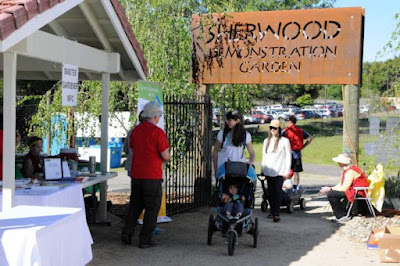

|
|
Sherwood Demonstration Garden welcomes visitors this week. (Photo courtesy UCCE Master Gardeners of El Dorado County)
|
El Dorado County master gardeners invite public to Sherwood Demonstration Garden in Placerville
When it comes to gardening, the foothills are different.
Compared to Sacramento, it’s often colder in the Sierra foothills. Tomato season starts later; for some crops, the growing season is shorter. And some plants actually appreciate the difference. (And don’t forget about deer!)
Find out how to make the most of your foothill garden at Open Garden Days at Sherwood Demonstration Garden in Placerville.
From 9 a.m. to noon Friday and Saturday, July 8 and 9, the UC Cooperative Master Gardeners in El Dorado County will open their demonstration garden to the public.
“As Master Gardeners, we are committed to educating the general public on sustainable horticulture and pest management practices based on traditional, current, and evolving research,” say the master gardeners. “It is our goal that the
Sherwood Demonstration Garden
will provide the public with a hands-on, interactive experience about research-based, sustainable gardening practices specific to the west slope of El Dorado County, appropriate for all ages and cultures, and reflective of a variety of environments and gardening experiences.”
Sherwood includes
16 individual demonstrations gardens
, ranging from water-wise All-Stars and butterfly habitat to shade lovers and vegetables. Even if you garden elsewhere, it’s a wonderful and inspirational place to visit.
During Open Garden Days, master gardeners are out in force to demonstrate their techniques and offer advice. Got garden questions? These folks have answers (or know where to look).
Admission is free. Parking is $2. No dogs please.
Sherwood Demonstration Garden is located at 6699 Campus Drive, Placerville, on the El Dorado Center campus of Folsom Lake College.
For more information and directions:
https://mgeldorado.ucanr.edu/Demonstration_Garden/
.
— Debbie Arrington
Comments
0 comments have been posted.Sacramento Digs Gardening to your inbox.
Food in My Back Yard Series
April 29: What's (already) wrong with my tomato plants?
April 22: Should you stock up on fertilizer? (Yes!)
April 15: Grow culinary herbs in containers
April 8: When to plant summer vegetables
April 1: Don't be fooled by these garden myths
March 25: Fertilizer tips: How to 'feed' your vegetables for healthy growth
March 18: Time to give vegetable seedlings some more space
March 11: Ways to win the fight against weeds
March 4: Potatoes from the garden
Feb. 25: Plant a fruit tree now -- for later
Feb. 18: How to squeeze more food into less space
Feb. 11: When to plant? Consider staggering your transplants
Feb. 4: Starting in seed starting
Sites We Like
Garden Checklist for week of May 4
Enjoy this spring weather – and get gardening!
* Plant, plant, plant! It’s prime planting season in the Sacramento area. Time to set out those tomato transplants along with peppers and eggplants. Pinch off any flowers on new transplants to make them concentrate on establishing roots instead of setting premature fruit.
* Direct-seed melons, cucumbers, summer squash, corn, radishes, pumpkins and annual herbs such as basil.
* Harvest cabbage, lettuce, peas and green onions.
* In the flower garden, direct-seed sunflowers, cosmos, salvia, zinnias, marigolds, celosia and asters. (You also can transplant seedlings for many of the same flowers.)
* Plant dahlia tubers. Other perennials to set out include verbena, coreopsis, coneflower and astilbe.
* Transplant petunias, marigolds and perennial flowers such as astilbe, columbine, coneflowers, coreopsis, dahlias, rudbeckia and verbena.
* Keep an eye out for slugs, snails, earwigs and aphids that want to dine on tender new growth.
* Feed summer bloomers with a balanced fertilizer.
* For continued bloom, cut off spent flowers on roses as well as other flowering plants.
* Add mulch to the garden to maintain moisture. Mulch also cuts down on weeds. But don’t let it mound around the stems or trunks of trees or shrubs. Leave about a 6-inch to 1-foot circle to avoid crown rot or other problems.